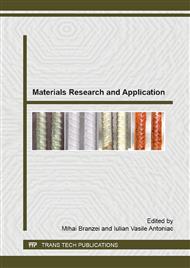p.233
p.239
p.247
p.253
p.258
p.266
p.272
p.278
p.283
In Vitro Assessment of a New Proposed Biomaterial and Dental Implant Abutments Understatic Load
Abstract:
The purpose of our study was to compare the mechanical properties of the different abutment under the static loading, aspect treated by many researchers [1-4], especially following the improvements given by the new proposed three-piece abutment, described below. We evaluated the effect of compression loading on the screw joint stability of the two-piece abutment and a new proposed three-piece abutment connected to an internal hexagon implant in vitro.The dental implant used was type AlphaBio SPI with an internal hexagon shape with following dimensions: length 13mm and diameter 3.75mm. The two types of abutment were used: the common type consisting of two piece straight titanium abutment and the second type consisting of three piece abutment (two titanium pieces and the third piece made of UHMWPE). For two-piece titanium implant/abutment systems with a screw-retained connection, the respective prefabricated straight abutments were tightened with a torque gauge using titanium abutment screws (type M-TLA) according to the manufacturer’s instructions. In the second case, the first titanium piece was a connector base between the implant and the UHMWPE abutment body which is assembled all together with the implant abutment fixation screw. The experimental systems were positioned in bovine cortical bone with a central hole (3.75 mm in diameter), and mechanical characteristics were evaluated using mechanical tensile tests. The mechanical tensile tests were carried out using INSTRON 3382 tensile test equipment. All tensile tests were performed at a constant strain rate of 1mm/min until a maximum elongation of 4mm. Stress-strain tensile curves were obtained for each experimental system.There were significant differences in the case of using the system with three piece abutment and we could conclude that this type of abutment assure a lower pressing on the entire system due to the shock absorbent properties of the piece made by UHMWPE.
Info:
Periodical:
Pages:
266-271
Citation:
Online since:
July 2015
Authors:
Keywords:
Price:
Сopyright:
© 2015 Trans Tech Publications Ltd. All Rights Reserved
Share:
Citation:


